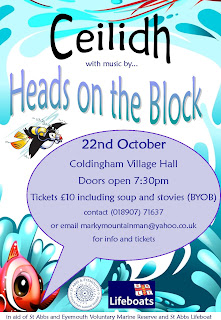 This week is Borders Tree Hugging week - no, I haven't made it up, its an event being organised by Borders Forest Trust for raise awareness (and funds) to help with the conservation of the woodlands of the area. And, being a bit of a tree fan myself, I have thrown myself into this with gusto, and I decided to start off at St Abbs. "Trees at St Abbs", I hear you cry, "you must be joking?!" Well, I'm not - believe it or not there are actually 33 different types of trees on the species list for the National Nature Reserve. So I decided, what better way to start off Tree Hugging Week than to remind myself (and others!) of all the fabulous trees that are right here on our doorstep.
This week is Borders Tree Hugging week - no, I haven't made it up, its an event being organised by Borders Forest Trust for raise awareness (and funds) to help with the conservation of the woodlands of the area. And, being a bit of a tree fan myself, I have thrown myself into this with gusto, and I decided to start off at St Abbs. "Trees at St Abbs", I hear you cry, "you must be joking?!" Well, I'm not - believe it or not there are actually 33 different types of trees on the species list for the National Nature Reserve. So I decided, what better way to start off Tree Hugging Week than to remind myself (and others!) of all the fabulous trees that are right here on our doorstep.Most of the trees at St Abb's Head are concentrated around the Mire Loch, pl
 anted here in the early 1900s when the dam was built to form the loch for fishing. But there is also quite a concentration at the car park (where the old farmhouse and its gardens used to be) and around Northfield House. So, I decided to take a circular route from the car park, along the coast path (passing alongside Northfield House gardens, where a fair few trees overhang the wall), then around the Mire Loch and back to the car park again. Without having to deviate far from the path I managed to hug 21 different species of tree of all sorts of sizes. From the knarled and wind-sculpted hawthorns of an old hedgeline (probably pre-dating the Mire Loch) to the east of the Mire Loch (picture top left) to the newly planted ash along the west of the loch (picture right).
anted here in the early 1900s when the dam was built to form the loch for fishing. But there is also quite a concentration at the car park (where the old farmhouse and its gardens used to be) and around Northfield House. So, I decided to take a circular route from the car park, along the coast path (passing alongside Northfield House gardens, where a fair few trees overhang the wall), then around the Mire Loch and back to the car park again. Without having to deviate far from the path I managed to hug 21 different species of tree of all sorts of sizes. From the knarled and wind-sculpted hawthorns of an old hedgeline (probably pre-dating the Mire Loch) to the east of the Mire Loch (picture top left) to the newly planted ash along the west of the loch (picture right).Purists might tut and shake their heads to see so many types of trees in the area that would not naturally be here. For instance, most of the mature trees around the Mire Loch are sycamore, which are not nativ
 e to Britain. But at St Abbs they form an important part of the woodland habitat and we are happy to have them. Having said that, when we do plant more trees, we are sticking to native species these days.
e to Britain. But at St Abbs they form an important part of the woodland habitat and we are happy to have them. Having said that, when we do plant more trees, we are sticking to native species these days.So, why not get out on the reserve this weekend and see how many types of tree you can spot (and hug if you fancy!)? We have put some laminated ID sheets in the visitor centre to help you use leaves, twigs and seeds to tell what is what. It can be tricky sometimes, as the windy and salty conditions at St Abbs have resulting in trees taking on weird and wonderful shapes (see the larch pictured left). But you don't actually need to know what they are called in order to enjoy them, so don't so tied up in looking at the ID guides that you miss the beauty of the trees themselves!
For those of you who like tick lists, here is a list of the species I hugged: alder, ash, beech, silver birch, blackthorn, wild cherry, elder, hawthorn, hazel, horse chestnut, larch, pedunculate oak, osier, scots pine, rowan, sitka spruce, sycamore, common whitebeam, goat willow, crack willow, yew.
If you would like to find out more about Tree Hugging Week or the BFT, go to http://www.bordersforesttrust.org/support-us/tree-hugging-week





